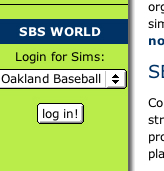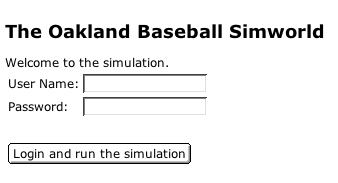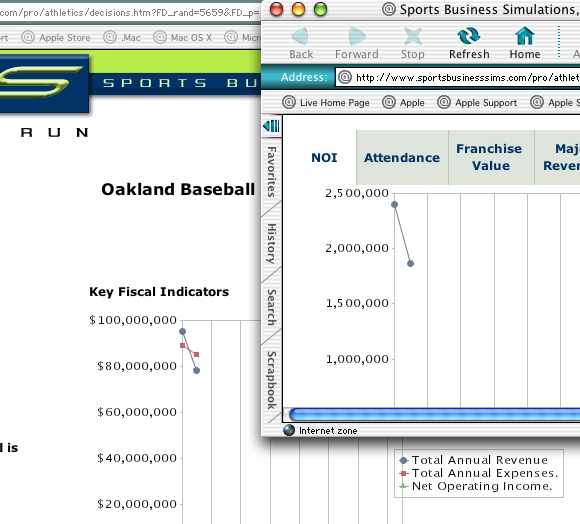Need tickets? Click here. Get sports and concert tickets here at SBS.
Sports Business Simulations • What
We Do
Sports Business Simulations produces Internet-based simulations of sports teams
and leagues for use in the college classroom or as sports fantasy games.
What is a simulation?
 A
simulation is a powerful tool for explaining actions and phenomena in society is
to assemble representations of the observed actions for review
and evaluation. This in its simplest form is called a model. A
simulation is a powerful tool for explaining actions and phenomena in society is
to assemble representations of the observed actions for review
and evaluation. This in its simplest form is called a model.
A simulator is an advanced type of model that generally takes the
form of some set of equations or materials designed to mimic the
behavior and structure of the environment or thing it represents.
Models, unlike simulators, can be static (like a model airplane).
But a simulator is designed to produce an action much like what it is designed to
represent (a simulated airplane cockpit is designed to work like a real one).
The most common example are airplane simulators. Pilots use these devices to learn how to fly large
jumbo jets.
These simulators allow the user to try techniques and make errors
that would be costly and even life-ending in the real world.
Simulators have evolved beyond use in aviation and taken on many
forms. But simulation as a field has grown with the advent of personal
computers. With software that enabled one to build complex forecasts of
financial and work process patterns, simulation entered a new industry:
business management. But even with the emergence of the use of
simulation in business, the worlds of sports and business and simulation
did not intersect.
Why simulate the sports business?
Sports is such an integral part of culture, and the focus so much
on the accomplishments of the individual player, that the public
seldom recognizes it as an industry, particularly in America.
The reality is that sports, by some estimates, is between $200
billion and $400 billion in size. A typical professional football
game in America will draw more people than live in many towns,
and employ 1,000 people. Some athletes -- pro basketball player Michael
Jordan offering the best example -- command multi-million-dollar
salaries, large game attendance figures, and annual product endorsement contracts greater than
$10 million in some cases.
Sports stadiums cost between $10 million and as much as $1 billion.
In the American context, these large facilities are paid for with
a combination of government and private sector money. This fact
alone is controversial, raising the question of the best use of
tax-payer dollars.
From the perspective of the owners of the teams
that need new stadiums, paying for these costly facilities without
some financing partner places all of the cost burden on their organization,
hampering their ability to afford high-priced athletes (generally
the reason why the owners feel they need a new stadium).
 Because
of the enormous expenditures and revenues commonly associated with
modern sports, and the occasionally complex interplay of public
and private interests, the sports industry provides a rich subject
ground for simulation. But simulation is not commonly used in the
sports industry, beyond simple spreadsheets which are primitive
forms of simulation. Where simulation is applied in sports, it
is to mimic the actions on the playing field, like Madden NFL 200X, by EA Sports. Indeed, the vast
majority of sports simulations are of the playing field, and not
the business itself. Because
of the enormous expenditures and revenues commonly associated with
modern sports, and the occasionally complex interplay of public
and private interests, the sports industry provides a rich subject
ground for simulation. But simulation is not commonly used in the
sports industry, beyond simple spreadsheets which are primitive
forms of simulation. Where simulation is applied in sports, it
is to mimic the actions on the playing field, like Madden NFL 200X, by EA Sports. Indeed, the vast
majority of sports simulations are of the playing field, and not
the business itself.
Moreover, while sports management and economics classes are growing
in number around the world, there is no web-based tool designed
to permit the student to simulate how sports teams and leagues behave
from a business standpoint. That's the reason for the development
of the products of Sports Business Simulations.
SBS simulation operating process
Running an SBS sim is a simple process. It starts when you go to
the SBS login area on the SBS World home page. Just select the sim
you want to visit, then press the "log in" button.
 Step
One: You will be taken to the login page for that sim (currently
your choices are the XFL Simworld and the Oakland Baseball Simworld).
In the near future, there will be more sims, all available via the
SBS World Gateway. Step
One: You will be taken to the login page for that sim (currently
your choices are the XFL Simworld and the Oakland Baseball Simworld).
In the near future, there will be more sims, all available via the
SBS World Gateway.
Step Two: At the login page (shown below), you simply type in your
username and password. Then press the "Login and run the simulation"
button.
 Both
the username and the password are provided by SBS after you have
purchased a SBS World Membership. Both
the username and the password are provided by SBS after you have
purchased a SBS World Membership.
Step Three: Clicking on the button, takes you to the front page
of the archive page of the simulation you choose, or if this is
your second time using the sim, with an account, you will see the
archives page. There, you can call up a past sim run, or start a
new one, or go to SBS JobLink. The archives page is capable of storing
a large number of sim runs. So you can start a run, stop in the
middle of it, and return later.
Step Four: Once you decide which sim to use, old or new, you will be taken to the front page of the
one you select. There, resides a brief presentation of the simulator, with
this prompt called "Begin Simulation." Press it, and you
will officially enter the play environmnent.
Step Five: Once in the sim environment, you start by reviewing
graphs and charts and decision instructions before actually selecting
what decisions you're going to make. Some managers have a predetermined
"business plan" they work from, and adjust it as they
go.
Depending on the simulation, the combination of decisions you can
make for any given time period can reflect actual business approaches
or ideas not used in comon practice, but possible.
Step Six: Once the analysis period is done, you make your set of
decisions for that year, or time "round." 
Step Seven: After you have completed your selections, you scroll
down to a button called "Submit Decisions" and press it
once. The screen will refresh and the outcome of the sim run for
that period will be evident from change in the animated charts and
graphs, along with other comments on the organization's performance.
This varies depending on the condition of the run and the sim you
are using.
You can copy tables and transfer them to a spreadsheet for further
analysis, or (depending on the computer) open the table directly
in MS Excel.
Simulations are fun
In addition to the ability to "run" a sports team or
league and better understand key economic and business management
principals , simulations are just plain fun. SBS's simulations
record player scores and encourage competition between students.
SBS
has discovered that students actually learn faster, because they're
motivated to understand how to better run the simulated organization.
We invite sports fantasy players to join the SBS world. You will
find our simulation experience richer, because of our focus on representing
how sports teams and leagues actually behave from a business perspective.
If your interested in the dynamics of player trades and negotiations
in the real sports world, join Sports Business Simulations.
In closing, we encourage you to become a member of the exciting
world of Sports Business Simulations. If you have special simulation
needs, please contact us. We will be happy to talk with you. If
you represent a sports team or league, we wish to partner with
you in the development of a simulation that represents your business.
Please contact us about our SBS
Sports Partners Program.
Simulation Links
Our strategic alliance partner, Forio Business Simulations, has
excellent articles on simulation and e-learning. Please visit their
site, at www.forio.com.
Simulation Articles
 Popular
Theory Supporting the Use of Computer Simulation for Experiential
Learning - David T. Bill
Computer simulated environments have advanced significantly in the past 10
years. Recent advancements in graphics and processor technology have allowed
for the creation of realistic electronic environments that closely replicate
the job environment. Promising research and development in the areas of virtual
reality and simulation engines are yielding glimpses of how future training
and education may delivered. http://www.centurionsys.com/rtcl57.html Popular
Theory Supporting the Use of Computer Simulation for Experiential
Learning - David T. Bill
Computer simulated environments have advanced significantly in the past 10
years. Recent advancements in graphics and processor technology have allowed
for the creation of realistic electronic environments that closely replicate
the job environment. Promising research and development in the areas of virtual
reality and simulation engines are yielding glimpses of how future training
and education may delivered. http://www.centurionsys.com/rtcl57.html
The 2002 US Market for E-Learning Simulation
Brandon-Hall's survey of the e-learning simulation market, with
projections through 2011. www.brandon-hall.com/simmarket.html
- 12k
Simulation Emerges as Best Use of E-Learning:
Brandon-Hall's second report http://www.brandonhall.com/public/pressreleases/simulations.htm
|

